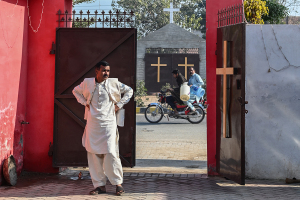The Church of the Holy Sepulcher and Its Tortured History
There are few places as diminutive from the outside and yet grandiose on the inside as the Church of the Holy Sepulcher. The church was built originally in 325 A.D. by Constantine's mother. He was the first emperor of Rome to officially convert to Christianity. He razed a former temple of Venus which had been built on the site several hundred years before during Hadrian's effort to rename Jerusalem Aelia Capetolina.
The site is of course traditionally believed to be the place where Jesus was crucified and where he was later resurrected in the presence of his twelve disciples. It also known to house the last four Stations of the Cross.
The building you'll visit today however is not the original building, nor is it even the original remade building or even the remade original building. In fact, few places have been destroyed and rebuilt more times than the Church of the Holy Sepulcher. The church was destroyed by Persians in 614A.D. and then rebuilt for the first time soon after that. However, the church was to see additional destruction, being burned to the foundations in 1009 A.D. by Hakim, the Sultan of the Muslim Caliphate at the time (he's sometimes known as "Hakim the Mad").
It was partially rebuilt later in 1048 A.D. when money was provided by Constantine IX of the Byzantine Empire. However, the church built by Constantine IX's money was not nearly as grand as the original church that Constantine had built. While no official explanation is offered for this, it's reasonable to assume that the Byzantine Empire, of which Constantine was ruler at the time was already facing a sharp decline, which eventually led to its ultimate destruction so he simply didn't have the money to do the rebuilding properly.
A proper rebuilding effort would have to wait until 1505 A.D. when a group of Franciscan monks came to the Holy Land with the intention of remaking the Church of the Holy Sepulcher into something truly grand and spectacular. The monks succeeded spectacularly; however what you'll see when you visit today is still not much of what they built.
That's because their vision was largely destroyed in 1808 when the church once again was burned to the ground, though this time by accident rather than deliberately. It was rebuilt yet again at that time and at the same time, a number of different groups began to lay claim to the church, with the groups now sharing power amongst themselves.
The groups include the Greek Orthodox Patriarchate, the Eastern Orthodox Church, the Armenian Apostolic Church, the Coptic Orthodox Church, the Syriac Orthodox Church, the Ethiopian Orthodox Church and the Roman Catholic Church, under the auspices of the Vatican. However, the primary power in the church rotates between the Armenian Apostolic Church, the Greek Orthodox Church, the Eastern Orthodox Church and the Roman Catholic Church (the Greek Orthodox Church however maintains most of the control of the building).
A renovation plan was begun again in 1959 and it continues to cause controversy with each group who controls the church jockeying for position and the Israeli government attempting to get the parties to talk so that the church can be properly preserved without prejudicing any one group's claims t the church. An old ladder rests outside one of the windows of the church and has been there at least since the middle of the 19th century. However, because the various factions who control the church have not been able to agree on how to renovate it, the ladder has remained in place all this time.
Because the church has so many different groups claiming ownership and was rebuilt at various time (parts date from the 1048A.D. construction, other parts from 1505A.D. and most parts either from 1808A.D. or from the modern renovations begun in 1959 A.D.), it can seem pretty confusing with different styles dominating different parts of the building. However, the over-all effect is still quite stunning and beautiful.
The most important place in the church is of course the place of the crucifixion, where it is believed that the Jesus' cross was placed outside the city walls of Jerusalem in 33 A.D. (There is another, competing location which was identified in the 19th century called the Garden Tomb, however most people still look to the Church of the Holy Sepulcher as being the place of the actual crucifixion of Christ.). This part of the church is run by the Greek Orthodox Patriarchate and includes what some describe as a "rocky outcropping" where the cross is believed to have been placed. The area includes the 12th station of the cross, which is the rock of cavalry and 11th station of the cross, which is run by Franciscan monks. There is also the "Chapel of the Nailing of the Cross" in the same area. The 13th station of the cross is there as well, with a statue of Mary Mother of Jesus and that is where His family moved Him after He was killed on the cross (according to most traditions).
The Stone of Anointing, where the body of Jesus was prepared by Joseph of Arimathea before it was buried is located just inside the entrance to this area.
The Edicule is the place where Jesus was initially buried after he died on the cross. The cave is no longer there having been destroyed completely by Hakim (that would be "Hakim the Mad" who we mentioned above) in 1009 A.D., however the tradition that this is the place where the cave was initially is quite strong.
The "Tomb of Joseph of Arimathea" is here as well and it is an actual tomb dating from the time of Jesus. It's largely looked to as archeological proof that the place is indeed the final resting place of Christ. However, while archeologists have been able to date the tomb to the time of Jesus, there are no markings and the area was actually discovered fairly recently during renovations in the building.
Two locations inside the Church of the Holy Sepulcher also lay claim to being the Prison of Christ, where Jesus was held before His crucifixion.
A number of chapels are located in the Armenian part of the church as well, including the Chapel of St. Helena and the Chapel of St. Vardan, which is said to contain relics from Hadrian's temple to Venus and Constantine's original church. There is also the Chapel of the Invention of the Holy Cross, where the original cross Jesus was crucified on was said to have been found and finally the Chapel of Mary Magdalene, where Jesus' mother met Him after His resurrection.
Over all, the church is really an overwhelming place to take in and as we said at the beginning of this article, it's all accessed through a small door which makes it all the more unique of an experience.
The church is located at the corner of Suq Khan e-Zeit and Christian Quarter Rd in Jerusalem's Old City.





























